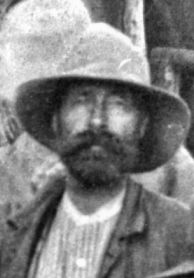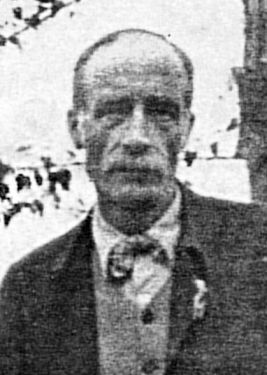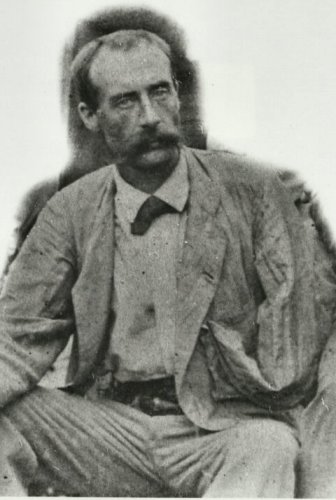Back to search results
Name: SMITH, Algernon Fox Eric CB (Lieut.-Col.)



Nee: son of Eric Smith, banker
Birth Date: 18.4.1857 London
Death Date: 25.1.1942 Grantham, England
Nationality: British
First Date: 1890
Profession: Administration Officer sent to occupy a post at Wyaki's Village, quite close to what was later known as Fort Smith He arrived about April 1891. Before the fort was completed Wyaki came to terms with Smith. Known as Eric Smith or A.E. Smith.
Area: Fort Smith, Kampala, Port Alice, Naivasha
Married: Unmarried
Book Reference: Gillett, Cuckoo, North, Best, Hobley, Ainsworth, Permanent Way, Watt, Boyes, Kill, Moyse, Kenya Diary, Tucker, Debrett, EAHB 1905, North, Curtis, Fitzgerald, IBEA, EAHB 1906, Nicholls, Eton, EAHB 1904, Chandler
War Service: Royal Life Guards
School: Eton
General Information:
Cuckoo - mentions a Colonel Eric Smith, late of the Life Guards - amputated his own arm after being grievously injured by a rhino and far from medical aid. Served in BEA and Uganda with the military force commanded by Lugard during the Chartered Company's time; also throughout the Uganda Mutiny of 1897. The story is related of him that, when forming camp one night during punitive operations, he always built a formidable thorn-bush zareba around it, closed all possible means of exit and entrance, and then dropped his guards to their posts outside. Faced with being murdered by the mutineers and afraid to desert their posts, the sentries could be relied upon not to sleep on duty but to maintain a strict guard over the encampment. His plan invariably proved effective.
Best - A young Life Guards officer who had somehow lost one hand during his tour in Kenya.. He became the first of many Britons to administer large portions of the protectorate singlehanded. Fort Smith was founded by him - it 'was a formidable affair, oblong in shape, and surrounded by a ditch which was in itself a difficult obstacle; and this was still farther strengthened by a barbed wire fence on the glacis. Flank defence was afforded by a bastion and two caponnieres, and the work itself was entered by two drawbridges.' ........…..
Ainsworth - On completing the fort, Capt. Smith proceeded directly west to Lake Victoria and Mr Purkiss, who had been his assistant, was left temporarily in charge pending the arrival of Capt. Nelson (late of the Emin Pasha Relief Expedition) who had been appointed Superintendent of the Kikuyu District. On Nelson's arrival Purkiss proceeded to Uganda and arrived in due course at the Kake, where, however, he went down with fever and was sent back to Kikuyu. By the time he reached Fort Smith he was much better and he was just in time to take over the station on the death of Captain Nelson.
Permanent Way - Commanding Kampala Fort when Sir Gerald Portal arrived there on March 17th 1893. 1st Life Guards, he had previously been the Company's commandant at Kikuyu.
Boyes - at Ravine - met Major Smith after whom Fort Smith named. He was an ex Life Guardsman and had had a very interesting career in the early days of BEA, and had lost one hand in the course of his adventures.
Kill - I [Foran] have only met 3 men who have been injured at all seriously by rhino - Major Stigand, Benjamin Eastwood and Col. Eric Smith. They all survived to relate their experiences but two of them Eastwood and Col. Smith lost an arm.
Debrett - formerly Major 1st Life Guards; E. Africa 1890 (mentioned in despatches), S. Africa 1899-1901 as Comdt. 10th Batn. Imperial Yeo. (mentioned in despatches, CB), E. Africa 1915-18 (despatches); is Hon. Lieut.-Col. in the Army
EAHB 1905 has Col. E. Smith - East Africa Syndicate Ex. Mrs V. Bellers - letter Nov 1996 - 'I have managed to piece together some information about "The Major" as he was known. He was related through marriage to the Collyers and appears to have been close to Arthur and Olive as we have photographs of them together in Kenya at the beginning of the century. He served in the Life Guards and he joined the IBEA Co. and was in EA in the 1890s, perhaps even earlier. His job appears to have been to lead caravans from the Coast to Uganda. (He refused to serve under Lord Lugard, so Lugard says, because Eric outranked Lugard). Somewhere in his life he lost part of his left arm. According to Sir Frederick Jackson, Col. Smith holds the record for the fastest march from Mombasa to Uganda. When the railway was built Col. Smith was put aboard a train for a few miles. When asked what he thought of it, he said, "Better than walking. Better than walking."
North - IBEA Co. - Forced to leave Life Guards after loss of left arm; seconded to Company from British Army; arr. Mombasa 12/6/1890 ... with Sir Francis de Winton; with Company police during 1st Witu expedn. 23/10/1890 to 30/10/1890; led expedn. to explore access to Lake Victoria for railway, Dec. 1890; Retd. from army with hon. rank of Major 21/7/1892; dep. Mombasa upcountry 6/9/1892; founded Fort Smith at Kikuyu 1892; dep. Mumia's 17/11/1892, arr. Kampala 6/12/1892; appt. 1st Class Asst. UP 1/7/1893; Kavirondo Nov 1893; Port Alice 22/12/1895; 1st Class Asst. UP 1896; sent to set up new station at Naivasha Feb 1896; Ravine station Jan 1899
Curtis - p. 35 - Life at Fort Smith - '....... In 1892 Major Eric Smith had built for the Company a station at Kabete in Kikuyuland. It was situated about two and a half miles north of the post at Dagoretti established by Lugard 2 years before, and 8 miles to the west of the future Nairobi. ..…
Fitzgerald - Observations of the variations in the level of Victoria Nyanza from Port Alice in 1896
EAHB 1905 - IBEA Co. General Africa Staff - appointed 1890
IBEA Co. - Nominal List of British Born Subjects resident in IBEA Territories outside the Sultans Domain, 30 April 1891 - A.E. Smith, England, Opening road to Lake
IBEA - General Africa Staff - Appointed 20th May 1890
Uganda Journal - Vol 23, p.146 - Captain Smith's Expedition to Lake Victoria - Retired from 1st Life Guards on loss of arm; 1890-93 with IBEA Company; 1895-9 Uganda Government transport service "He led caravans to and fro between Mombasa and Uganda more times than anyone else" - Sir Frederick Jackson, 'Early Days in East Africa' 1930. Detailed account of the expedition.
Nicholls - [Dagoretti fort] - Wilson was visited in January 1891 by Captain Eric Smith, of the 1st Life Guards, a man sent inland by IBEAC to explore a route for a possible railway. It may have been the behaviour of some of the men in Smith's caravan which poisoned relations with the local Kikuyu, for on 30 March Wilson felt it prudent to retire from dagoretti fort, a wise move as the Kikuyu then overrran and burnt it. When new supplies arrived with a caravan led by George Leith, who took over Machakos from Bateman, Wilson reoccupied Dagoretti but soon left it and joined Smith on the way back to the coast. There he was dismissed from the Company - according to Ernest Gedge, for 'seduction, and flogging a man to death' on the evil report of the blackguards Leith and Bateman.
Nicholls - Born in 1857, Smith had to leave the Royal Life Guards after he lost an eye and his left arm. Somewhat curmudgeonly, he was inclined to squabble with colleagues and never became popular. He joined IBEAC in 1890 from the British Army, and became expert in organising and participating in caravans to Uganda (though he refused to serve with Lugard on a march to Uganda because he was militarily senior to Lugard).
V. Bellers - connection with Smith's Bank at 1 Lombard Street …..I have also concluded that, probably because he was rather rich, Eric may have been the member of the family in Kenya who had a good camera because amongst my photos there are some really clearly defined ones which is amazing for photographs about 100 years old.
Back to search results



